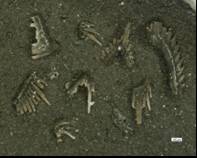AmericanChemicalSociety.com
Reports: ND8 49237-ND8: A Paleotemperature Proxy Record Across the End-Permian Extinction Horizon and Through the Triassic Recovery Interval from Oxygen Isotopes in Conodont Apatite
Adina Paytan, PhD, University of California (Santa Cruz)
As much as 96% of marine species diversity was lost at the end of the Permian, 252 million years ago; a similar proportion of the terrestrial biota also went extinct. The mass extinction event occurred in less, and possibly much less, than 500 ky. The ultimate and proximal causes of the extinction event remain actively debated. Bolide impact has been proposed as a trigger, but the strength of the evidence has been challenged. Recent studies have pointed primarily toward Earth-based extinction mechanisms. The most widely cited terrestrial triggers are the overturn or upwelling of deep water from a stratified, anoxic ocean or the eruption of the Siberian Traps flood basalt province. Either of these scenarios proposes substantial global warming across the Permian-Triassic boundary (PTB). Paleobiological and sedimentological evidence for climate change as well as a large negative excursion in d13C all point toward warmer temperatures. Despite the central role of paleoclimate and pCO2 in PT extinction scenarios, there are few isotope proxy constraints on paleoclimate through this interval. Existing bulk-rock carbonate d18O records may be compromised by diagenetic alteration whereas d18O records from biogenic phosphates are too sparse to draw meaningful conclusions there are few measurements published for the entire Early Triassic. The major goal of this ongoing research is to develop a d18O record from conodont apatite for the Late Permian through Middle Triassic by taking advantage of an ideal field locality in southern China where expanded stratigraphic sections on a carbonate platform span both the PTB interval and the full Early and Middle Triassic an interval of more than 15 My.
To this end in the first year of the project we have refined a micro-precipitation procedure to extract, purify and precipitate apatite phosphate to silver phosphate, optimized and standardized the mass spectrometer for conducting analyses on small samples and analyzed a subset of existing conodont samples at UC Santa Cruz. In addition we have conduct additional sampling in China to supplement sample coverage near the Permian-Triassic boundary and other intervals of interest identified from initial d18Op results and existing d13C data. Over 300 rock samples were collected and their stratigraphic sequence recorded. Samples were acidified in China and residues were shipped back to the USA. For the past 6 months conodonts are being separated from the acid residues using heavy liquids and conodonts are picked, photographed and described. For some intervals taxon-specific replicate samples are obtained to test for biotic effects or effects associated with life in different parts of the water column. The work is tedious and time consuming, yep progress is made and we have assembled conodont separates from about 50 distinct intervals (Figure 1). In the next year the samples will be processed and analyzed for d18Op and results interpreted. The results of this study will help to constrain PTB carbon cycle models, GCMs, and extinction and recovery scenarios.
Working on geological sections from the Permian and Triassic is new to me and my research group as we have not ventured into such deep time before. The project exposed us to complications associated with sections exposed to long and continuous diagenetic processes including metamorphism, uplift, and surface weathering. The work provided exciting opportunities for me and my students to work with collaborators ion China and UA and Canadian institutes and specifically with expert paleontologists and field geologists that enhanced our exposure to the broad spectrum of Earth Science research.
Figure 1. Conodonts from the Lower Guandao section, variety of element types from the latest Permian
Copyright © American Chemical Society


